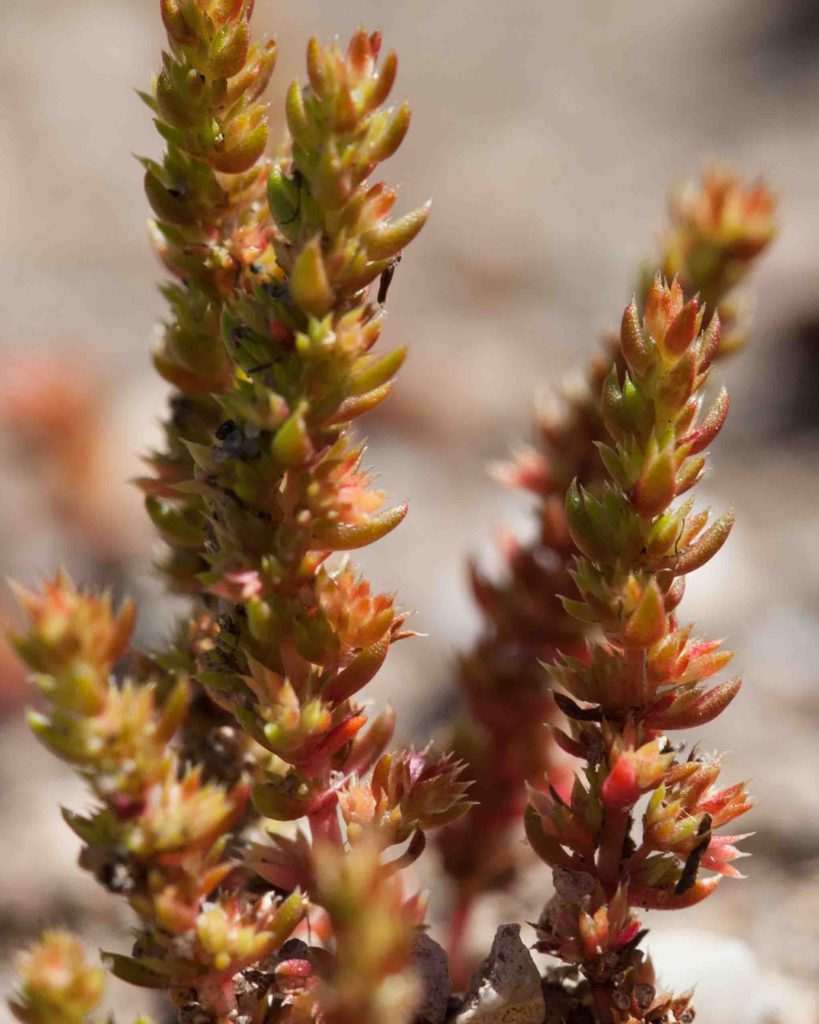Crassulaceae: Stonecrop Family — Crassula & Sedum
The Stonecrop family members are mostly succulents, with basal rosettes of fleshy leaves. Dudleya has numerous flowers, more or less cylindric, ranging from bright yellow to deep orange-red. Other genera, e.g. Sedum (Stonecrop) and certain Crassula have star-shaped flowers. Some plants in this family have an unusual photosynthesis variation, called CAM (Crassulacean Acid Metabolism). These plants conserve water by keeping their pores closed during the day, and opening them at night.
[Sand] Pygmy-weed – Crassula connata
Blooms:
Feb–May
Plant Height:
2–6 cm
Flower Size:
Very small
Origin:
Native
Habitat:
Dry open areas, gravelly places
Notes:
This is similar to the non-native Moss Pygmy-weed (Crassula tillaea, see below), but its flowers have 4 sepals rather than 3. Also, its appearance is less spiky. Its color ranges from green when young, to reddish in maturity. Photo #4 by CJH.
Fairy Crassula – Crassula multicava subsp. multicava
Blooms:
Mar–May
Plant Height:
20–40 cm
Flower Size:
Small
Origin:
South Africa
Habitat:
Garden escape
Notes:
This is a much-branched perennial, with a panicle-like terminal inflorescence of small, pinkish-white, cruciform flowers. The fleshy leaves are elliptical in shape. It belongs to the same genus as the Pygmy-weeds and the commonly-cultivated Jade Plant (Crassula ovata), but is utterly different in appearance.
Moss Pygmy-weed – Crassula tillaea
Blooms:
Feb–May
Plant Height:
2–6 cm
Flower Size:
Very small
Origin:
Mediterranean
Habitat:
Open gravelly places
Notes:
This is similar in size and growth habit to the native Pygmy-weed (Crassula connata, see above), but its flowers have 3 sepals rather than 4. It also has a rather more spiky overall appearance. Its color ranges from green when young to reddish in maturity.
Broad-leaved / Pacific Stonecrop – Sedum spathulifolium
Blooms:
Apr–Aug
Plant Height:
5–22 cm
Flower Size:
Small
Origin:
Native
Habitat:
Rocks in damp, shady places
Notes:
This is a low-growing succulent. It is most easily recognized by its rosettes of small (1–2 cm long), spoon shaped leaves in prominent rosettes. The flowers are an undistinguished greenish-yellow to orange, and star-shaped (about 15 mm across). Given where it is generally found, this species fully justifies the English name for its family.












